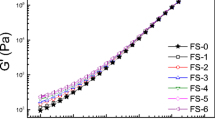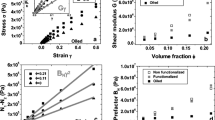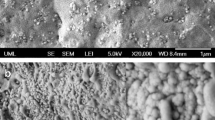Abstract.
The dynamic properties as a function of frequency and strain amplitude, steady-state viscosity as a function of shear rate, and transient shear stresses at startup and cessation of shear flow of polystyrene (PS)/fumed silica mixtures of various concentrations were investigated. An abrupt change in the viscoelastic properties was noticed at a concentration above 1% by volume. Observations by means of scanning electron microscopy (SEM) indicate the presence of a three-dimensional network through the bridging of filler particles by the adsorbed polymer. The viscoelastic behavior is simulated utilizing a theory proposed in Part I (Havet and Isayev 2001) based on a double network created by the entangled polymer matrix and the adsorbed polymer with filler concentration taken into account through the bridging density of polymer-filler interactions and a hydrodynamic reinforcement. The steps taken for determining the model parameters required to carry out the simulation are described. The major features of the rheological behavior of highly interactive polymer-filler mixtures are captured qualitatively and in some cases, quantitatively predicted.











Similar content being viewed by others
References
Aranguren MI, Mora E, DeGroot JV, Macosko CW (1992) Effect of reinforcing fillers on the rheology of polymer melts. J Rheol 36:1165–1182
Bueche F (1960) Molecular basis for the Mullins effect. J Appl Polym Sci IV:107–114
Castellani L, Lomellini P (1994) Phase volume and size effects on the terminal relaxation of ABS melts. Rheol Acta 33:446–453
Clark AT, Lal M (1982) Effect of polymers on dispersion properties (Tadros TF (ed)). Academic Press, NY
Coussot P, Leonov AI, Piau JM (1993) Rheology of concentrated dispersed systems in a low molecular weight matrix. J Non-Newtonian Fluid Mech 46:179–217
Donnet JB (1998) Black and white fillers and tire compound. Rubber Chem Technol 71:323–341
Doraiswamy D, Mujumdar AN, Tsao I, Beris AN, Danforth SC, Metzner AB (1991) The Cox-Merz rule extended: a rheological model for concentrated suspensions and other materials with yield stress. J Rheol 35:647–685
Doremus P, Piau JM (1991) Yield stress fluid. Structural model and transient shear flow behaviour. J Non Newtonian Fluid Mech 39:335–352
Fleer GJ, Cohen Stuart MA, Scheutjens JMHM, Cosgrove T, Vincent B (1993) Polymers at interfaces. Chapman and Hall, NY
Frankel NA, Acrivos A (1967) On the viscosity of a concentrated suspension of solid spheres. Chem Eng Sci 22:847–853
Havet G, Isayev AI (2001) A thermodynamic approach to the rheology of highly interactive filler-polymer mixtures. Part I. Theory. Rheol Acta 40:570–581
Inn YW, Wang SQ (1993) Transient network model for a multiphase polymeric fluid. Rheol Acta 32:581–588
Joppien GR (1974) Strukturuntersuchungen an adsorptionsschichten makromolekularer Stoffe,1. Makromol Chem 175:1931
Kawaguchi M, Takahashi A (1982) The structure of macromolecules adsorbed on interfaces. In: Behavior of macromolecules, Adv Polym Sci, vol 46, Springer, Berlin Heidelberg New York
Kawaguchi M, Maeda K, Kato T, Takahashi A (1984) Preferential adsorption of monodisperse polystyrene on silica surface. Macromolecules 17:1666–1671
Kosinski LE, Caruthers JM (1985) Rheological properties of poly(dimethylsiloxane) filled with fumed silica. II. Stress relaxation and stress growth. J Non-Newtonian Fluid Mech 17:69–89
Kosinski LE, Caruthers JM (1986) Effect of molecular weight on the rheological properties of polydimethyl siloxane filled with fumed silica. Rheol Acta 25:153–160
Leonov AI (1990) On the rheology of filled polymers. J Rheol 34:66–81
Leonov AI, Simhambhatla M (1995) On the rheological modeling of filled polymers with particle-matrix interactions. Rheol Acta 34:329–338
Lipatov YS (1980) Adhesion and adsorption of polymers. In: Lee LH (ed) Polymer Science and Technology, 12B. Plenum Press, NY
Lipatov YS (1995) Polymer reinforcement. ChemTec Publishing, Toronto
Maier PG, Goritz D (1996) Molecular interpretation of the Payne effect. Kauts Gummi Kunstst 49:18–21
Maron SH, Pierce PE (1956) Application of Ree-Eyring generalized flow theory to suspensions of spherical particles. J Colloid Sci 11:80–95
Montes S, White JL (1993) Rheological models of rubber-carbon black compounds: low interaction viscoelastic models and high interaction thixotropic-plastic-viscoelastic models. J Non-Newtonian Fluid Mech 49:277–298
Moore ER (1989) Styrene polymers. In: Encyclopedia of polymer science and engineering, vol 16. Wiley, New York, pp 1–246
Payne AR, Whittaker RE (1972) Effect of vulcanization on the low-strain dynamic properties of filled rubbers. J Appl Polym Sci16:1191–1212
Quemada D (1984) Models for rheological behavior of concentrated disperse media under shear. In: Mena B, Garcia-Rejon A, Rangel-Nafaile C (eds) Advances in rheology, vol 2. Universidad Nacional Autonome de Mexico, pp 571–582
Sobhanie M, Isayev AI (1999) Modeling and experimental investigation of shear flow of filled polymer. J Non-Newtonian Fluid Mech 85:189–212
Sobhanie M, Isayev AI, Fan X (1997) Viscoelastic plastic rheological model for particle filled polymer melts. Rheol Acta 36:6–81
Suetsugu Y, White JL (1984) A theory of thixotropic plastic viscoelastic fluids with a time dependent yield surface and its comparison to transient and steady state experiments on small particle filled polymer melts. J Non-Newtonian Fluid Mech 14:121–140
Treloar LRG (1975) The physics of rubber elasticity, 3rd edn. Clarendon Press, Oxford
Upadhyay RK, Isayev AI, Shen SF (1981) Transient shear flow behavior of polymeric fluids according to the Leonov model. Rheol Acta 20:443–457
Vinogradov GV, Malkin AY, Plotnikova EP, Sabsai OY, Nikolayeva NE (1972) Viscoelastic properties of filled polymers Int J Polym Mater 2:1–27
Wang MJ, Wolff S, Donnet JB (1991) Filler elastomer interactions. Part I. Silica surface energies and interactions with model compounds. Rubber Chem Tech 64:559–573
Winter HH, Chambon F (1986) Analysis of linear viscoelasticity of a crosslinking polymer at gel point. J Rheol 30:367–382
Author information
Authors and Affiliations
Corresponding author
Rights and permissions
About this article
Cite this article
Havet, G., Isayev, A.I. A thermodynamic approach to the rheology of highly interactive filler-polymer mixtures. Part II. Comparison with polystyrene/nanosilica mixtures. Rheol Acta 42, 47–55 (2003). https://doi.org/10.1007/s00397-002-0253-z
Received:
Accepted:
Published:
Issue Date:
DOI: https://doi.org/10.1007/s00397-002-0253-z




